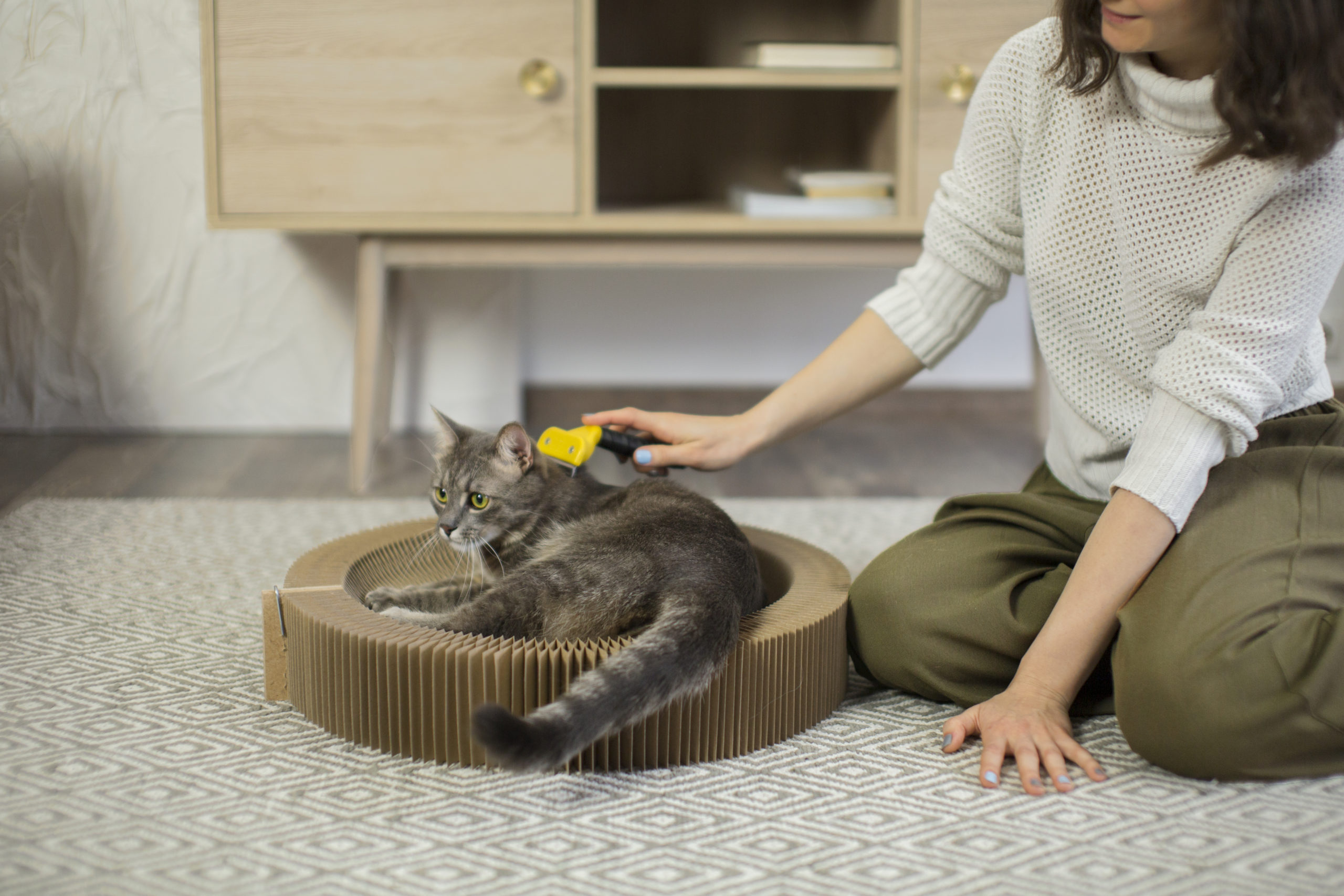Living with cats is rewarding, but it can also come with the challenge of dealing with unpleasant odors in your home. Whether it’s the smell of litter boxes, urine, or dander, cat odor can be persistent and difficult to eliminate.
However, there are proven methods for how to get rid of cat odor in your house, ensuring a fresh and clean living environment for you and your furry companions.
In this article, we will explore a range of proven techniques for eliminating cat odor, including using air purifiers and deodorizers, deep cleaning, and regular maintenance. With these tips and strategies, you can say goodbye to unpleasant cat odors and enjoy a comfortable and healthy home.
Effective methods to neutralize and eliminate the unpleasant cat odor in your indoor environment
Using air purifiers and deodorizers
Air purifiers work by filtering the air and capturing particles such as cat dander, hair, dust, and pollen. For optimal results, choose an air purifier with a HEPA filter that can trap even the smallest particles. Deodorizers work by neutralizing or masking the odor in the air, so choose a product specifically formulated for pets that is also safe to use around cats. Many deodorizers contain natural ingredients like activated charcoal or baking soda that can effectively absorb and eliminate odors. Some products even offer the benefits of both air purification and deodorizing in one.
Removing pet hair
Pet hair can trap odors and contribute to an unpleasant smell that can be difficult to remove. Regular vacuuming of floors and furniture using a vacuum cleaner with a HEPA filter can effectively eliminate pet hair and dander. Additionally, using a lint roller or pet hair remover to clean clothing, bedding, and other fabrics can help to remove hair and odors. Regular brushing of your cat can also help reduce shedding, which can lead to a fresher-smelling home.
Ventilating your home
Ventilation allows fresh air to circulate, removing any stale air and lingering pet odors. Opening windows and doors is an effective way to increase air circulation, but if this is not possible, consider installing a ventilation system designed for optimal air flow. A well-designed system can prevent unpleasant odors from accumulating and keep air moving throughout your living space. Insulation is also critical in maintaining a comfortable temperature and preventing drafts.
Using baking soda
As a natural deodorizer baking soda can absorb and neutralize unpleasant smells on various surfaces, such as carpets, furniture, and fabrics. To use baking soda, generously sprinkle it over the affected area and leave it for at least 30 minutes, or overnight for better results. Then, vacuum or sweep it up. For fabrics, mix baking soda with water and apply it directly to the affected area before washing. Adding a small amount of baking soda to your cat’s litter box can also help control odor.
Using citrus
The natural oils found in citrus fruits such as lemons, oranges, and grapefruits can neutralize unpleasant odors. To use citrus, cut a lemon or orange in half and place it in a bowl in the room where the odor is coming from. Boiling citrus peels in water on the stove can also create a natural air freshener. Additionally, you can sprinkle citrus zest over carpets, rugs, and furniture to absorb odors. Mixing lemon or orange juice with water in a spray bottle is another option for a natural deodorizing spray. Citrus is a safe and non-toxic alternative to chemical air fresheners, making it an excellent choice for eliminating cat odors.
Using white vinegar
As a natural disinfectant, it can neutralize and remove unpleasant smells. To use white vinegar, mix equal parts of vinegar and water in a spray bottle and apply it to the affected area. Allow the solution to sit for a few minutes before wiping it up with a clean cloth. You can also use vinegar to clean cat litter boxes and other areas where your cat spends time. Simply mix vinegar with water and use it to clean the litter box or surrounding area. Additionally, vinegar can remove pet stains from carpets and upholstery. First, blot up any excess moisture with a paper towel, then apply a mixture of vinegar and water to the stain. Allow the solution to sit for a few minutes before blotting it up with a clean cloth.
Deep cleaning carpets
Cat urine and dander can penetrate deep into carpet fibers, causing persistent odors that surface cleaning may not eliminate. Deep cleaning involves using a steam cleaner or carpet shampooer to penetrate the carpet fibers and extract dirt, dust, and odor-causing particles. These machines use hot water and cleaning solution to break down dirt and debris, leaving your carpet looking and smelling fresh. To ensure all cat odors are removed, it’s important to use a cleaning solution designed for pet stains and odors. A carpet deodorizer can also be used after deep cleaning to neutralize any remaining odors.
Using an enzyme cleaner
Enzyme cleaners work by breaking down the proteins in cat urine and removing the bacteria that cause the unpleasant odor. Enzyme cleaners come in different forms, such as sprays, foams, and powders, and can be used on various surfaces, including carpets, furniture, and floors. To ensure the best results, it’s crucial to follow the instructions provided with the cleaner and allow it to soak in for the recommended time. After applying the cleaner, make sure to blot the area with a clean cloth or towel to remove any excess moisture.
Using a HEPA air filter
HEPA air filters can capture tiny particles, such as pet dander and other allergens, reducing the odor caused by cat urine. The HEPA filter can trap more than 99% of particles as small as 0.3 microns, smaller than most pet allergens. The filter operates by pulling air through a fine mesh that captures airborne particles, including those that cause odor. You can use a standalone HEPA filter or incorporate it into your home’s heating and cooling system. Replacing the filter frequently is crucial to maintain its effectiveness.
Using an odor-neutralizing spray
These sprays work by breaking down and neutralizing the molecules that cause odor, rather than simply masking them with a scent. You can use odor-neutralizing sprays on various surfaces, including furniture, carpets, and fabrics, to eliminate cat odor. To ensure maximum effectiveness, it’s crucial to choose a spray that is specifically designed for pet odors. When using an odor-neutralizing spray, it’s essential to follow the instructions carefully and use the recommended amount. Using too much spray can cause residue buildup, leading to new odors.
Replacing old furniture
As time passes, cat urine and dander can accumulate on furniture and penetrate deep into the fabric, creating stubborn odors that may not go away with cleaning alone. If you’ve attempted to clean your furniture without success, it’s time to consider replacing it. Opt for furniture with removable and washable covers, as this will make cleaning more accessible and help prevent odor buildup over time. Leather or vinyl furniture can also be a good alternative, as they are less absorbent than fabric and easier to clean. When selecting new furniture, choose pieces that are easy to maintain and clean to prevent the buildup of cat odor in the future. Regularly vacuuming and dusting your new furniture can also help prevent odors from developing.
Tips for Preventing Future Cat Odors After Getting Rid of Them in Your House
Regular cleaning routine
Cleaning litter boxes daily can prevent the accumulation of urine and feces, which can cause unpleasant odors. Vacuuming carpets, rugs, and furniture regularly can remove pet hair, dander, and other particles that contribute to the smell. Consistently washing your cat’s bedding and toys can help prevent bacterial growth and minimize odors. Using a disinfectant spray to clean surfaces like countertops, floors, and walls can eliminate any bacteria or particles that cause unpleasant smells. Keeping your home well-ventilated by opening windows and using fans can improve air circulation and reduce the concentration of pet odors.
Proper ventilation
Enhancing air circulation by opening windows or using fans can help reduce the concentration of pet odors. If you have a central air system, using HEPA filters can remove allergens, dust, and other particles that contribute to unpleasant pet smells. Air purifiers are also effective in removing pet dander and hair from the air to prevent the accumulation of odor-causing particles. It’s important to ensure adequate ventilation when using cleaning products or other chemicals to prevent the worsening of pet odors. Activated carbon filters can effectively eliminate stubborn odors, so consider using them if necessary.
Consistent litter box maintenance
Maintaining a clean litter box is essential to prevent future cat odors in your home. Make it a daily habit to scoop your cat’s litter box to prevent the accumulation of urine and feces that cause unpleasant odors. Regularly changing the litter and washing the box with soap and water can also help minimize odors. Opt for an odor-neutralizing litter that contains activated carbon or baking soda to absorb and eliminate odors. Placing the litter box in a well-ventilated area can also help reduce the concentration of pet odors. If you have multiple cats, make sure to provide enough litter boxes to prevent overcrowding, which can lead to increased odors.






0 Comments